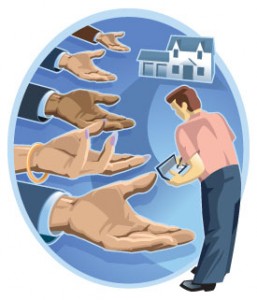 A lot of lenders these days are offering a “no closing costs” option if you take out a mortgage. With this option, the lender pays the closing costs for you, but you pay a slightly higher interest rate on the loan.
A lot of lenders these days are offering a “no closing costs” option if you take out a mortgage. With this option, the lender pays the closing costs for you, but you pay a slightly higher interest rate on the loan.
This can be a good idea in some circumstances. But you have to run the numbers to find out if it’s right for you.
The appeal of a “no closing costs” loan is obvious: Closing costs can be expensive! The national average of closing costs for a $200,000 purchase-money mortgage is more than $4,000, according to a survey by Bankrate.com. And that figure can vary considerably by state: In New York, the most expensive state, the average total of closing costs for the same mortgage is $6,183.
On very expensive homes, it’s possible to have closing costs that are north of $10,000.
For many people who are struggling to come up with a 20% down payment, the idea of avoiding closing costs is very attractive.
On the other hand, if you accept a loan with a higher interest rate, you’ll be paying the higher rate for the entire life of the loan, which means you could be paying many thousands of dollars extra as the years go by.
How to decide
In order to decide whether a “no closing costs” option is right for you, the first step is to determine which closing costs the lender will actually pay. While the option is typically billed as “no closing costs,” some lenders actually only pay for certain of the closing costs, and you’ll still have to pay for others.
Find out, for instance, if you’ll still be on the hook to pay for such items as a title search, title insurance, appraisal fees, credit check costs, and so on.
Next, once you know exactly what items you won’t have to pay for, determine how much you’ll save by not paying for them.
Then figure out how much more you’ll pay each month with the higher interest rate. Divide your total savings by the extra payment each month, and you’ll have the number of months it will take you to break even.
For instance: If you save $6,000 in closing costs and you pay an extra $50 a month with the higher interest rate, then you’ll break even in 120 months…which is 10 years. But if you save $3,600 in closing costs and pay an extra $100 a month on your mortgage, then you’ll break even in 36 months…which is only three years.
In general, you’ll come out ahead if you plan to get rid of the mortgage – by selling the home or refinancing – before the “breakeven” point.
So if your breakeven point is 10 years, and you plan to live in the house for only five to seven years, the “no closing costs” option might make good financial sense. But if the breakeven point is three years and you plan to live in the house much longer than that, you’re probably better off paying the closing costs and enjoying a lower interest rate.
Taking the “no closing costs” option is often a good idea if you plan to refinance in a short time. But with interest rates at historic lows, it’s not clear that refinancing a few years from now is a safe bet.
Even if you expect to keep your loan beyond the breakeven point, the “no closing costs” option might still be worthwhile if it’s the only way you can come up with a 20% down payment. The higher interest rate might still be better than what you’d have to pay if you can’t put down 20%.
One other thought is that if you expect to keep your loan beyond the breakeven point, but you’ll use the money you save on closing costs to improve the property, and you would otherwise take out a home equity line of credit for this purpose, you might be better off with the “no closing costs” option. That’s because the additional interest you’ll pay on the mortgage might be less than the interest you’d pay on the home equity line.

